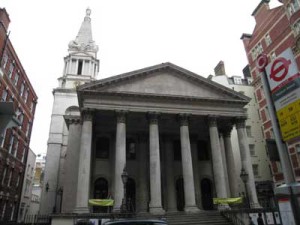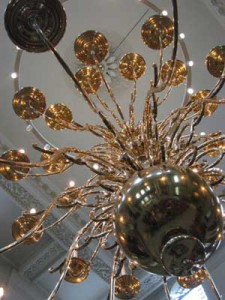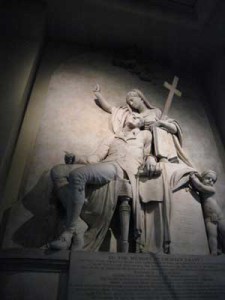 |
| Front Elevation of St George’s Bloomsbury, 6-7 Little Russell Street, London Photo © Heather Shimmin |
In 1711, worried about England’s spirituality and the deplorable lack of churches, Queen Anne ordered 50 churches to be “built of stone and other proper materials, with Towers or Steeples to each of them” in the City of London and Westminster. Only 12 were constructed, 6 of which were by Nicholas Hawksmoor (the other 5 were Christ Church, Spitalfields; St Mary’s, Woolnoth; St George’s in the East, Wapping; St Anne’s, Limehouse; and St Alfege, Greenwich). St George’s in Bloomsbury was the last to be built. St George’s was consecrated on 28 September 1730 and replaced the old parish church of St Giles-in-the-Fields.
Nicholas Hawksmoor was England’s master Baroque architect. English Baroque is a less flamboyant version of the Continent’s over the top Baroque style. Hawksmoor created complex interior spaces, playing with the relationship of space and light. St George’s is eclectic and bold. The focus is a large Corinthian portico above the entrance inspired by the temple of Bacchus at Baalbek, Lebanon.
 |
| Brass chandelier on long-term loan from the V&A. Photo © Heather Shimmin |
Over the next 50 years, major changes to the structure were made in order to accommodate the growing congregation; the last major change was reconfiguring the orientation of the nave from east/west to north/south in 1780. The gallery was also dismantled and the ornamental screen covering the alter was moved from the east end of the chapel to the south end, as well.
THOUGHTS
All of these structural changes to the church must have made Nicholas Hawksmoor turn over in his grave. I’m getting a little ill just thinking about all them. St George’s was designed for a specific purpose: it was designed as an “auditory church,” a church for the liturgy of the Book of Common Prayer. By making all of these (horrible) changes, the building’s acoustics, not to mention aesthetics, suffered greatly. Before the restoration began, the walls were painted blue and gold.
This was the last church that Hawksmoor built. This is the probably one of the compelling reasons for the major restoration of St George’s. England loves Hawksmoor.
The restoration began to bring the church back as Hawksmoor intended began in 2002. The restoration is coming along nicely. The gallery has been restored (or completely rebuilt since was dismantled entirely) and the alter has been moved back to its original east/west orientation. I still have a hard time wrapping my head around the idea of completely moving the altar in a church. I just don’t see it.
 |
| Variation of the Pieta, the sculpture is bathed in natural light coming in from the first storey windows. Photo © Heather Shimmin |
They are looking to all of Hawksmoor’s drawings and designs to make the church as accurate to his original intension as possible.
A new addition to the parish church is a magnificent, 17th century, three tier brass chandelier which hangs in the centre of the square nave of the church. It is on long-term loan from the V&A. It hung in the main reception of the Victoria and Albert Museum for 100 years! The V&A replaced the brass chandelier with something else and was wondering what to do with this one. They thought it would be fitting to hang it in St George’s and how right they were. It fits the space very nicely. I took a moment to sit down and sketch the chandelier. It’s amazingly complex, with dozens of swooping arms coming out in organized chaos, topped by electric candles.
The church feels light and airy, clean and inviting. I sat a while inside and enjoyed the space. I wondered around and took some photos, really enjoying Hawksmoor’s understanding of light and how it filters in through the windows.